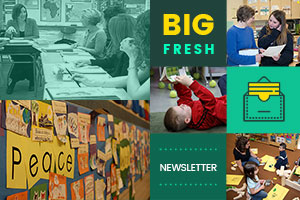What others call you, you become. It’s a terrible magic that everyone can do — so do it. Call yourself what you wish to become.
Catherynne M. Valente
Last spring I visited Brian Sepe, a literacy coach in western New York. We started the visit in his book-lined office, with Brian talking about his collaboration with teachers. “Literacy coach” is one of those roles that is defined in many different ways, so I asked Brian how he defined his work. “I see myself as a thought partner for teachers,” he explained. It was an interesting term, but I didn’t think much about it as we continued to chat. Then we started walking through the school, stopping in several classrooms. I noticed how almost every teacher used that phrase “thought partner” or something similar in describing their relationship with Brian:
It’s great to have a thought partner when I’m trying something new . . .
Bouncing ideas off someone any time you need to is what I like best about Brian . . .
We’re always talking about what I could do next or what the options are . . .
In one classroom, a teacher was attempting a new partner/discussion technique with her first graders she’d just learned in a short before-school PD session that morning. She was discouraged that it wasn’t going as well as she’d hoped, but Brian quickly assured her of good things he’d noticed. Then they brainstormed small tweaks she could make to the routine the next day for more success. In that moment, I saw what “thought partners” looked like.
One of the gimmicky trends in business is to eschew traditional labels for managerial roles. Some companies don’t have CEOs — they have “inspiration gurus.” Or a “creative superhero” instead of a president (you can’t make this stuff up). These goofy titles strike me as forced fun or an awkward stab at hipness for jobs that are usually anything but cool or joyous. What I loved about seeing Brian in action as a “thought partner” was the way the title brought clarity to the squishy responsibilities of literacy coaches. The title takes away the debate about whether coaches are supporters or evaluators (or even a little bit of both). Instead, Brian continually reinforces the notion that he’s right there in the heads of his colleagues, mulling over what works, what doesn’t, and what might be the way forward together.
How might you redefine your role in a project with colleagues or students through a new title? Maybe you are the “extra hands” in implementing a new language arts curriculum, finding books and online resources. Or the “extra heart” in keeping everyone grounded with new standards. Are you a curricular chef? What about the resources you provide for students or teachers? Is the literacy room a think tank, or an improvisation station? Name your role and work space with an eye toward what you want it to be, and you’ve taken the first step from possibility to reality.
This week we look at how to teach conventions. Plus more as always — enjoy!
Brenda Power
Founder, Choice Literacy
Free for All
[For sneak peeks at our upcoming features, quotes and extra links, follow Choice Literacy on Twitter: @ChoiceLiteracy or Facebook: http://www.facebook.com/ChoiceLiteracy or Pinterest: http://pinterest.com/choiceliteracy/]
Out of all the convention errors you might focus on in a conference, how do you make a choice? Heather Rader gives examples of how she navigates the tricky terrain of conferring over conventions with students:
http://www.choiceliteracy.com/articles-detail-view.php?id=1400
Our Pinterest board on teaching punctuation highlights 13 children’s books to use as mentor texts:
http://www.pinterest.com/choiceliteracy/mentor-texts-for-teaching-punctuation/
Grammar Girl’s Editing Checklist is a quick and handy reference you can download for figuring out what conventions to focus on in student minilessons and conferences, as well as proofing your own work:
http://www.quickanddirtytips.com/education/grammar/grammar-girls-editing-checklist
For Members Only
Melanie Meehan finds that a flexible conventions checklist that students develop according to their own needs is the best way to ensure conventions are taught in the context of authentic student work:
http://www.choiceliteracy.com/articles-detail-view.php?id=2414
In this week’s video, Melanie works with third graders to develop personalized conventions checklists:
http://www.choiceliteracy.com/articles-detail-view.php?id=1760
The “daily edit” is a common routine in many classrooms. Shari Frost explains why this may not be an effective way to teach conventions, and offers some alternatives:
http://www.choiceliteracy.com/articles-detail-view.php?id=2324
New PD2Go: Aimee Buckner uses a mentor text to demonstrate how writers construct lively nonfiction paragraphs. The small group has been pulled together because the students need more practice in adding details to their writing:
http://www.choiceliteracy.com/pd2go-11280
This video and workshop guide fulfill Common Core State Standard ELA-Literacy.W.4.2.a: Introduce a topic clearly and group related information in paragraphs and sections; include formatting (e.g., headings), illustrations, and multimedia when useful to aiding comprehension.
That’s all for this week!



